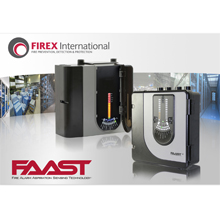 |
| The latest FAAST LT will be demonstrated as a flexible solution for challenging applications |
Honeywell will be demonstrating the latest FAAST next generation aspiration detection technologies at this year’s Firex on 17-19 June (Stand N625) at the Excel Centre in London.
Live product demonstrations will showcase the ultra sensitive EN54-20 approved FAAST XM device achieving false alarm immunity via unique patented technologies. FAAST LT will be demonstrated as a flexible solution for challenging applications. The latest new addition to the FAAST aspiration detection technology range being introduced at the show is FAAST XL, a high sensitivity four channel device offering class-leading leading levels of false alarm immunity, extensive coverage and integrated communications.
FAAST next generation aspiration detectors were launched in Europe two years ago and are increasing their market share due to their ability to provide the earliest warning detection with false alarm immunity in the most challenging environments.
Tim Checketts, EMEA Sales Manager, Speciality Products, will be giving a presentation on latest aspiration technologies during the show. He commented: “We exhibited FAAST at last year’s Firex and since then have won a significant number of high profile projects in applications demanding the earliest and most accurate smoke detection. This year the focus is on range extension and integration and the unique features within FAAST such dual optics and multi stage filtration which make it 65% more effective for false alarm immunity”.
“What is clear is that aspiration detection is fast becoming the detection method of choice for a far wider range of applications now such as airports, shopping developments, manufacturing facilities, pharmaceutical sites and high end property development. It’s no longer the remit of clean rooms and data centres. We expect this year’s Firex to be a great success and are looking forward to introducing another new product in the FAAST range.”
FAAST delivers a 65%+ improvement in false alarm immunity compared with traditional aspiration detectors.




